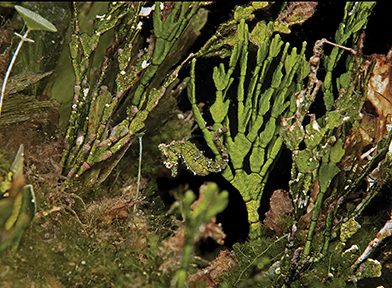OUR RECENT UNDERWATER ADVENTURE began with a fanciful quest to track down an inconspicuous little fish no larger than a nickel. In many ways our mini mission to find the seldom-seen dwarf seahorse (Hippocampus zosterae) seemed more like a weekend lark of carefree youngsters than the stalwart band of seven men and women tugging on wetsuits along the hardpan shoreline of the seldom-explored shallows of Florida Bay in Key Largo, Florida.
We hatched the hunt for the dwarf seahorse two years earlier around the dining table of longtime friend Richard Smith, PhD, in the Cotswolds of England. During our visit he reflected on the origins of his passion for observing every species of miniature seahorse in the wild.
His endeavor began soon after submitting his doctoral thesis in 2010 on the biology and conservation of gorgonian-associated pygmy seahorses. Over the ensuing years he extensively prospected Asian Pacific, Indian Ocean, and Red Sea waters to fulfill his dream. Along the way Smith coauthored two descriptive papers on recently discovered pygmy species from Japan and South Africa, and he was named a member of the International Union for Conservation of Nature’s Species Survival Commission Seahorse, Pipefish, and Seadragon Specialist Group.

Our afternoon chat soon switched to his recent invitation to speak at REEF Fest in Key Largo. The opportunity to share his wealth of seahorse stories with a gathering of like-minded fish enthusiasts happened to convene enticingly close to the historical population center of the dwarf seahorse’s home range. So, without hesitation, he jumped at the offer. The business of sorting out the logistics of our expedition, as usual, fell to Anna.
Unfortunately, her planning wasn’t rushed. The Reef Environmental Education Foundation (REEF) canceled the 2020 event due to COVID-19, and Smith could not fly to the U.S. the following year. In the interim Anna contacted marine life photographers from South Florida for some ideas on where to begin the hunt. In the end she located only two people with images, both of whom had found their dwarfs in seagrass meadows off a bayside park in the Middle Keys. The surprising shortage of photographs of such an intriguing species left the impression that the diminutive seahorse must be rare and endangered.
One strategy we all had in common was moving slowly or not much at all.
After a bit of sleuthing, Anna discovered that the aquarium trade annually removes large numbers of dwarf seahorses, many more are taken as bycatch during bait-shrimp trawling operations, and seagrasses — the species’ prime habitat — have experienced substantial die-offs. Despite all these setbacks, a 2019 analysis shows that population numbers in Florida Bay have stabilized or possibly increased and are estimated to number in the low millions.
The little wonders are not rare at all. They just typically inhabit unappealing, low-visibility bays and lagoons that divers seldom visit and are difficult to find even when searching for them.
On the October morning after the 2022 REEF Fest finale — two and a half years after the idea’s inception — our dream team of seven experienced fish watchers, including four with PhD credentials in marine science, waded out into Florida Bay from the shoreline of a Key Largo dive resort. Although hope ran high, we each harbored doubts about finding our thumbnail-sized targets designed by nature to survive by stealth. Once beneath the surface, we quickly broke rank, fanning out across a 6-foot-deep sea of grass like foxhounds with their noses to the ground, each diver guided by respective instincts and strategies fashioned over years of underwater hunting.
One strategy we all had in common was moving slowly or not much at all. I explored the tangles of seagrass that fringe bare sand patches, squinting from one blade to the next, constantly looking for the motionless phantoms holding fast with long prehensile tails. But search as I might, after 45 minutes no sign of a seahorse — dwarf or otherwise — had appeared.
Becoming distracted, I swam to the rugged limestone shore wall, where I unexpectedly found myself in an exquisite garden of algae cloaking the crags and crevices with a delightful tapestry of greenness. While musing on how the sea never ceases to amaze, I spotted an awkward scrap of tan nestled in a tuft of algae below.
It was Smith’s seahorse, the only one we found that day, but one was all we needed. And we wouldn’t have been happier if it had been gilded in gold. We had accomplished our miniature mission, but the fun had just begun.
On the following morning, armed with a search image and a better idea of where to hunt, we moved to a small coastal park a half mile up U.S. 1 and headed straight for the underwater shore wall hidden by a similar fairyland of green. Within 20 minutes Smith and Anna located half a dozen dwarfs along a 40-foot stretch.
Among the tally was a pregnant male displaying a bulging brood pouch brimming with maturing offspring as his lovely, emerald-green mate hid nearby with a fresh supply of eggs ready to provision yet another generation of seahorses for other lucky divers to find. AD
© Alert Diver — Q2 2023